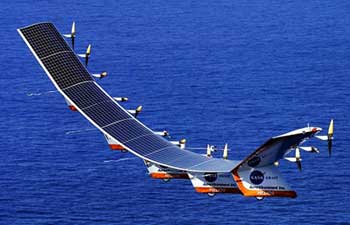NASA's Helios - Solar Powered Flying Wing

As a follow up to the Centurion (and earlier Pathfinder) aircraft, the solar-powered Helios Prototype was the latest and largest example of a slow-flying ultralight flying wing designed for long-duration, high-altitude Earth science or telecommunications relay missions in the stratosphere.
The Helios was intended to demonstrate two key missions: the ability to reach and sustain horizontal flight at 100,000 feet altitude on a single-day flight in 2001, and to maintain flight above 50,000 feet altitude for at least four days in 2003, with the aid of a regenerative fuel cell-based energy storage system now in development. Both of these missions were powered by electricity derived from non-polluting solar energy.
Unfortunately shortly after take off on June 26, 2003 the Helios broke apart and fell into the Pacific Ocean.
NASA's Helios

 Close up view of Helios' Avionic Pod. |
The Helios Prototype was in 2001 the latest and largest example of a slow-flying ultralight flying wing designed for high-altitude, long-duration Earth science or telecommunications relay missions. A follow up - on to the Pathfinder and Pathfinder-Plus solar aircraft, the Helios Prototype soared to 96,863 feet altitude in August 2001, setting a new world record for sustained altitude by winged aircraft, powered only by energy from the sun.
Developed by AeroVironment, Inc., of Monrovia, Calif., under NASA's Environmental Research Aircraft and Sensor Technology (ERAST) project, the unique craft was designed to demonstrate two key missions: the ability to reach and sustain horizontal flight near 100,000 feet altitude on a single-day flight, and to maintain flight above 50,000 feet altitude for almost two days, the latter mission with the aid of an experimental fuel cell-based supplemental electrical.
The remotely piloted Helios Prototype first flew during a series of low-altitude checkout and development flights on battery power in late 1999 over Rogers Dry Lake adjacent to NASA's Dryden Flight Research Center in the Southern California desert.
The Helios Prototype is an enlarged version of the Centurion flying wing that flew a series of test flights at Dryden in late 1998. The craft has a wingspan of 247 feet, 41 feet greater than the Centurion, 2 1/2 times that of the Pathfinder flying wing, and longer than the wingspans of either the Boeing 747 jetliner or Lockheed C-5 transport aircraft.
In upgrading the Centurion to the Helios Prototype configuration, AeroVironment added a sixth wing section, a fifth landing gear pod and a differential Global Positioning Satellite (GPS) system to improve navigation, among other improvements. The additional wingspan increased the area available for installation of solar cells and improved aerodynamic efficiency, allowing the Helios Prototype to fly higher, longer and with a larger payload than the smaller craft.
The second milestone established by NASA for its development a long-endurance demonstration flight of almost two days and nights required development of a supplemental electrical power system to provide power at night when the solar arrays are unable to produce electricity. AeroVironment developed an experimental fuel cell-based electrical energy system combining advanced automotive fuel cell components with proprietary control technology designed for the harsh environment above 50,000 feet altitude.
The first version of this system combines gaseous hydrogen from two pressurized tanks mounted on Helios' outboard wing sections with compressed oxygen from the atmosphere via a series of proton-exchange membrane fuel cell "stacks" mounted in the central landing gear pod. The system produces more than 15 kW of direct-current electricity to power Helios' motors and operating systems, with the only by-product being water vapor and heat. The system will increase the Helios Prototype's flight weight by about 800 lb to about 2,400 lb.
Two other versions of the system are contemplated: One, employing liquid hydrogen, would enable the Helios to fly for up to two weeks in the stratosphere anywhere around the Earth, not limited to temperate or equatorial latitudes. Another version, a closed or "regenerative" system, uses water, a fuel cell, and an electrolyzer to form a system similar in function to a rechargeable or "secondary" battery, but with much greater efficiency than the best rechargeable battery systems.
A production version of the Helios with the regenerative fuel cell system is of interest to NASA for environmental science, the military and AeroVironment for various roles, primarily as a stratospheric telecommunications relay platform. With other system reliability improvements, production versions of the Helios are expected to fly missions lasting months at a time, becoming true "atmospheric satellites."

Helios HP01 on its record setting flight on September 8, 1999 when it flew to an altitude of 96,863 ft
 Helios coming in for a successful landing. (Right): Helios seconds before it broke up on its June 26, 20003 flight. Helios coming in for a successful landing. (Right): Helios seconds before it broke up on its June 26, 20003 flight. |
 |
Specifications for the NASA Helios HP03
 |
Length: 16.5 ft Performance |
 |
| Wreckage of the Helios Prototype solar-electric aircraft floats in the Pacific Ocean near the Hawaiian island of Kauai shortly after the aircraft became uncontrollable and broke up during a test flight on June 26, 2003. About 75 percent of the wreckage was recovered, but the prototype fuel cell system that was to have provided power at night during the planned long-endurance flight demonstration sank in mile-deep water and could not be recovered. |

